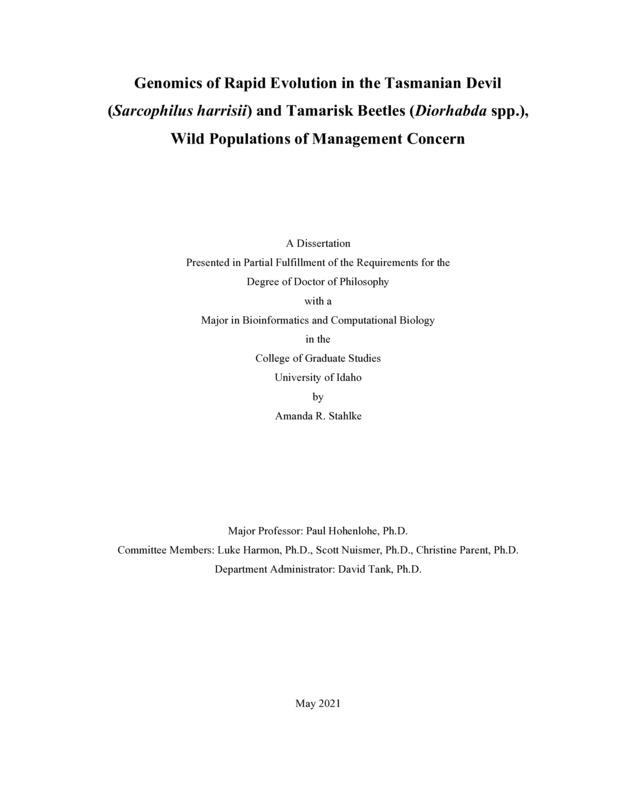Genomics of Rapid Evolution in the Tasmanian Devil (Sarcophilus harrisii) and Tamarisk Beetles (Diorhabda spp.), Wild Populations of Management Concern
Stahlke, Amanda Rose. (2021-05). Genomics of Rapid Evolution in the Tasmanian Devil (Sarcophilus harrisii) and Tamarisk Beetles (Diorhabda spp.), Wild Populations of Management Concern. Theses and Dissertations Collection, University of Idaho Library Digital Collections. https://www.lib.uidaho.edu/digital/etd/items/stahlke_idaho_0089e_12116.html
- Title:
- Genomics of Rapid Evolution in the Tasmanian Devil (Sarcophilus harrisii) and Tamarisk Beetles (Diorhabda spp.), Wild Populations of Management Concern
- Author:
- Stahlke, Amanda Rose
- ORCID:
- 0000-0001-5724-598X
- Date:
- 2021-05
- Keywords:
- Agriculture Biocontrol Disease Genome Assembly Hybridization Rapid Evolution
- Program:
- Bioinformatics & Computational Biology
- Subject Category:
- Genetics; Bioinformatics; Wildlife management
- Abstract:
-
We now recognize the pervasiveness of rapid evolution in the wild; yet it remains a challenge to identify the key patterns and processes to predict outcomes and inform management decisions. In this dissertation, I employ genomic tools and multi-scale analyses over molecules, space, and time to improve our understanding of the genomic context of rapid evolution in two systems of management concern: the Tasmanian devil, Sarcophilis harrisii, and a classical biological control (biocontrol) agent, the tamarisk beetle (Diorhabda spp.). In these taxonomically-distinct systems, the common management goal is essentially to allow or provide beneficial genetic variation for adaptation to novel selective forces while limiting the potentially adverse effects of fixation and introgression. By spanning the tree of life and the unique circumstances of these systems, we can better identify strategies informative to systems of management concern.
Tasmanian devils (Sarcophilus harrisii) are evolving in response to a unique transmissible cancer, devil facial tumor disease (DFTD), first described in 1996. Persistence of wild populations and the recent emergence of a second independently evolved transmissible cancer suggest that transmissible cancers may be a recurrent feature in devils. In Chapter 1, I use range-wide RAD capture data and publicly available marsupial genomes to compare signatures of selection across temporal scales. I test the hypothesis that genes or gene pathways under contemporary selection have also been subject to historical selection. I documented genome-wide contemporary and historical selection, but limited evidence of recurrent selection, with no functional enrichment shared among gene sets. My results are consistent with a novel, polygenic evolutionary response of devils to DFTD and can inform management actions to conserve adaptive capacity of devils by identifying high priority targets for genetic monitoring and maintenance of functional diversity.
In Chapter 2, I examine the genome-wide outcomes of introduction, spread, and gene flow in the four cryptic species of the tamarisk beetle (D. carinata, D. carinulata, D. elongata, and D. sublineata), introduced to control invasive tamarisk (Tamarix spp.) in North America. I assembled a de novo draft reference genome of D. carinulata and used reference-based RADseq to characterize the genetic variation associated with establishment, spread, and gene flow. I found differential establishment and spread among the six released populations. Despite evidence of a substantial genetic bottleneck among collections of D. carinulata in North America and low levels of genetic diversity, populations continue to establish and spread, with one ecotype dominating the southward expansion front.¬ I confirmed that Diorhabda hybridizes widely in the introduced range. Genetic diversity was greater in populations with hybrids, highlighting potential for increased adaptive capacity. These results provide a snapshot of introduced Diorhabda populations and lay the foundation for further application of genomics to understand contemporary eco-evolution in classical biological control programs.
In Chapter 3, I present high-quality assemblies of all four Diorhabda species using iterative, third-generation sequencing technologies, in collaboration with the United States Dep. Agriculture, Agricultural Research Service Ag100 Pest Initiative. I annotate these nearly chromosome-level assemblies with population genetic data to validate sex chromosome identification, compare the arrangement of single-copy orthologs, and characterize repeat content among the introduced biocontrol species. These resources dramatically improve our ability to identify mechanisms of rapid evolution in reproductive barriers, adaptation to novel environments, and physiological responses to plant hosts.
- Description:
- doctoral, Ph.D., Bioinformatics & Computational Biology -- University of Idaho - College of Graduate Studies, 2021-05
- Major Professor:
- Hohenlohe, Paul A
- Committee:
- Parent, Christine E; Harmon, Luke J; Nuismer, Scott L
- Defense Date:
- 2021-05
- Identifier:
- Stahlke_idaho_0089E_12116
- Type:
- Text
- Format Original:
- Format:
- application/pdf
- Rights:
- In Copyright - Educational Use Permitted. For more information, please contact University of Idaho Library Special Collections and Archives Department at libspec@uidaho.edu.
- Standardized Rights:
- http://rightsstatements.org/vocab/InC-EDU/1.0/

